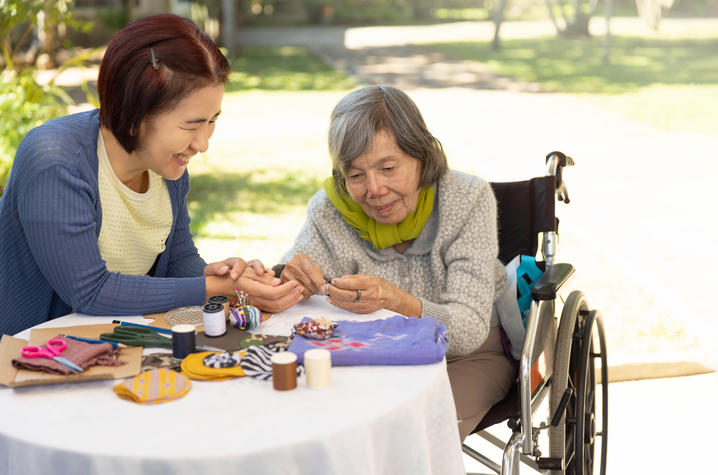Multi-Sensory Approach Benefits Communication With Those Living With Dementia

The University of Kentucky Public Relations and Strategic Communications Office provides a weekly health column available for use and reprint by news media. This week's column is by Elizabeth Rhodus, Ph.D., assistant professor at the University of Kentucky’s Sanders-Brown Center on Aging.
LEXINGTON, Ky. (May 2, 2022) — Are you caring for someone with dementia? We invite you to participate in a research study that offers the Harmony at H.O.M.E. (Help Online Modifying the Environment) telehealth program at the University of Kentucky. The program provides training and tools for care partners to assess and modify the home to promote activity engagement and behavior regulation for the person with dementia. This study is led by researchers within UK’s Sanders-Brown Center on Aging.
As the body and brain age, one’s ability to take in information, process the content, and respond may be substantially altered. Older adults often experience hearing loss which can diminish their ability to understand and engage in conversations. Eyesight also changes which impacts how older adults gather information, such as reading and writing. Dementia can also impact the brain’s ability to process information from the ears, eyes, hands and other sensory systems. For example, while a spoken message may be retrieved by the ears, the brain’s processing may be delayed or may not interpret all the information coming in. This, in turn, alters the speed and way the person with dementia responds.
A multi-sensory approach can increase success when communicating with someone with Alzheimer’s disease. Here are a few tips for using a multi-sensory approach:
Vision:
- Communicate in the person’s line of vision.
- Present yourself with contrast.
Hearing:
- Slow down when talking and provide pauses. It can take up to 90 seconds for someone with dementia to process what they hear.
- Sing. Rhythm and music enhance sensory processing and brain synchrony which helps the person process sounds faster.
Touch:
- Communicate with the hands. Hands often remain highly sensitive to touch, and so holding the hand of the person you are talking to will encourage their attention when communicating.
Smell and Taste:
- Set the mood with aromas.
- Please the palate. Splashes of flavor, such as lemon juice in water or something sweet can trigger increased awareness and attention when communicating.
Pressure:
- Gentle compression calms the mind. We can harness the calming and centering effect of a massage through gentle compression in the hands, arms, and shoulders when communicating.
Movement (Vestibular):
- Rocking soothes the body. Linear movement, such as sitting in a rocking chair or glider, is calming. This may be a helpful strategy prior to communicating or prior to engaging in care tasks.
Internal Feelings:
- Offer suggestions for personal needs. One’s awareness of internal feelings can decrease overtime, such as the feeling of being hungry or thirsty, being in pain, feeling hot or cold, or even feeling tired.
My past experiences as an occupational therapist and a motivation to enhance clinical care led me to develop the innovative intervention now known as Harmony at H.O.M.E., which emphasizes sensory-based techniques in the home environment for those living with dementia. For further information, please visit www.ccts.uky.edu/participate-research/current-studies/are-you-caring-someone-dementia.
As the state’s flagship, land-grant institution, the University of Kentucky exists to advance the Commonwealth. We do that by preparing the next generation of leaders — placing students at the heart of everything we do — and transforming the lives of Kentuckians through education, research and creative work, service and health care. We pride ourselves on being a catalyst for breakthroughs and a force for healing, a place where ingenuity unfolds. It's all made possible by our people — visionaries, disruptors and pioneers — who make up 200 academic programs, a $476.5 million research and development enterprise and a world-class medical center, all on one campus.




